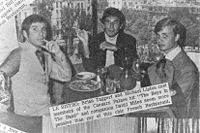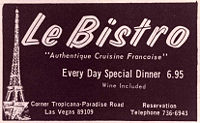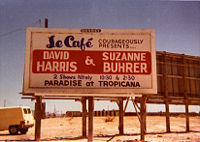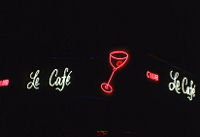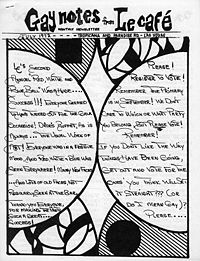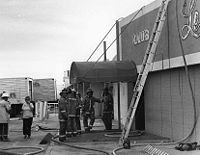Le Café
January 16, 1970 - The Opening of Le Café in Las Vegas
(c) Dennis McBride, 2009
Club Black Magic
Le Café opened originally as the Club Black Magic on August 18, 1954 at 4817 Paradise Road on the southwest corner of Tropicana Avenue, then known as Bond Road. The Black Magic was the most popular jazz club in Las Vegas throughout the 1950s and '60s. When musicians got off work on the Strip they gathered at the Black magic for all-night jam sessions. This night-stalker ambiance attracted show kids from the Strip, and people who lived on ranches in Paradise Valley rode their horses through the desert to the Black Magic and tied them to hitching posts out front.[1]
Le Bistro French
In November 1968 Camille Castro, a stylish and flamboyant European lesbian, opened Le Bistro French restaurant in the Black Magic, known by then as the Club de Paris. Camille had owned La Manche a Gigot restaurant on the Isle St. Louis in Paris among whose famous clientele were two well-known Las Vegans: Dunes Hotel owner Major Riddle and Line Renaud, star of the Dunes' Casino de Paris production. Camille was also associated with a celebrated Parisian lesbian bar called the Crazy Horse and she came to Las Vegas from Paris as the lighting engineer when Caesars Palace imported a show called the Crazy Horse Revue. When the revue went down, Camille, bankrolled by Riddle, stayed on to open her restaurant.[2]
Club de Paris and Le Bistro held their grand opening on January 10, 1969 and quickly became a favorite hangout for Las Vegas' gay community, particularly the show crowd from the Strip. Betty Grable, a Las Vegas resident at the time, often hosted parties at Le Bistro, and the cast of Boys in the Band, performing at Caesars Palace during the summer of 1969, gathered at Le Bistro. Las Vegas food critic Fedora Bontempi frequently reviewed le Bistro in her column in Panorama magazine noting that it was the first and the only authentic French restaurant in Las Vegas.[3]
Marge Jacques
By late 1969 both Le Bistro and the Club de Paris were failing when Marge Jacques became interested in running the bar. Marge had worked as a cocktail waitress at the Sands Hotel and was at the Golden Nugget during the late 1960s when Las Vegas was forced to integrate the casino industry first by hiring black dealers, then by hiring women dealers and she had been in the forefront of both fights. Marge obtained a liquor license, bought the Club de Paris, changed the name to Le Café, and held a grand opening on January 16, 1970. Marge's club was unique because she opened it publicly as a gay bar, which had never been done in Las Vegas before. Both Maxine's and the Red Barn, two other gay bars operating at the time, were low-key and closeted—but Le Café was gay out loud.
The club's motto, printed on matchbooks and t-shirts, was "Glitter and Be Gay at Le Café!" a motto which perfectly reflected 1970s gay disco glamour. The club's reputation spread around the world and throughout the 1970s Le Café was frequented by such entertainers as Liberace, Joan Rivers, Shirley Maclaine, Rip Taylor and Paul Lynde, Bobbie Gentry, Debbie Reynolds, Sammy Davis, Jr.—even Milton Burl.[4]
Voice of the Gay Community
It was through Marge Jacques and Le Café that the Las Vegas gay community first found its voice. Gay Notes from Le Café was the first gay publication in Las Vegas. Openly gay herself, Marge appeared on a local NBC television news show in 1976, taped in the living room of her own house, and she was the contact for a two-part Las Vegas Review-Journal series on gays in Las Vegas in 1977. It was Marge and friends and employees from Le Café who founded the first Las Vegas chapter of the National Organization for Women in 1971 and who wrested control of the Clark County Democratic Party from the Mormon Church in the mid-1970s. Marge was in demand as a lecturer on gays and gay life and addressed groups at the University of Nevada, Las Vegas and Nellis Air Force Base. [5] (read a 1977 eyewitness account for Le Café)
Fire
But the good times ended on August 24, 1978 when Le Café was torched. It was never determined beyond doubt who burned Marge's club, although rumor in the gay community had it that she was burned out by the owner of a bar down the street at 4310 Paradise Road called Prelude. That owner was Camille Castro, who had sold Le Bistro to Marge, left the country, then returned in 1975 to open a new bar and disco in direct competition with Le Café. There were rumors, too, that Marge had burned her own club, although at the time of the fire she had failed to update her insurance and lost everything. A second fire on May 5, 1979 completely gutted the empty building.[6]
For the next five years Marge operated a number of other gay bars in Las Vegas including the Other Place at 5410 Paradise Road and the Village Station, which became the Gipsy in 1981.[7]
Disco Le Café Bar and Restaurant
When Marge lost the Gipsy in 1983, she resurrected Le Café as Disco Le Café Bar and Restaurant in the old Country Rebel Steakhouse at 2710 E. Desert Inn Road. Her partners in this venture were noted casino designer Don Schmitt, entertainer Breck Wall, and businessman Warren Fulbright. Disco Le Café had its grand opening on October 20, 1983. The nightclub came alive at night with drag, Punk, and New Wave shows, while the restaurant side hosted meetings of groups and organizations both straight and gay. The rooms were decorated with paintings by performer/designer Joey Skilbred, while a huge fireplace kept the foyer and restaurant warm. The menu featured dishes named after famous gay people such as James Dean Hot Cakes and the Bessie Smith Platter. For awhile some of the glamour that had made the first Le Café world famous was reborn at Disco Le Café.[8]
But Disco Le Café died a quick death. Its East Desert Inn location worked against it because it was too remote from the Paradise Road/Naples area known as the Fruit Loop; Marge was aiming for a high-end clientele that didn't exist in Las Vegas then; and the bar owners in the Fruit Loop, angry with Marge's competition, spread rumors that the cops were following gay people from the Fruit Loop on their way to Disco Le Café and ticketing them on trumped-up DUIs. It was an effective lie which, taken with the other factors working against Marge, killed the bar. On April 13, 1984, the Women's Concerns Group of Nevadans for Human Rights arrived at Le Café for their monthly meeting only to find the doors locked. [9]
Le Café, closed the day before, had passed into history.
Image Gallery
Notes
- ↑ Las Vegas Review-Journal 08/17/1954, p. 9; Ibid. 01/13/1955, p. 11; Ibid. 01/30-1955, p. 7
- ↑ Panorama 01/10/1969, p. 3; Ibid. 11/28/1969, p. 20; Marge Jacques interview; Karin Rodgers interview; Ralph Vandersnick interview
- ↑ Panorama 2/07/1969, pp. 12, 16; Ibid. 08/02/1969, pp. 17, 20; Ibid. 08/29/1969, pp. 21, 23; Jacques; Rodgers; Sally MacEachern interview
- ↑ Jacques; Bert Hood interview; Hanford Searle interview; Panorama 9/30/1977, p. 13; Ibid. 10/7/1977, p. 15; Ibid. 10/28/1977, p. 14; Ibid. 10/23/1977, p. 19
- ↑ Jacques; Searle; Gay, 5.10.71, 9; Las Vegas Review-Journal 07/31/1977, section 1B; Ibid. 08/07/1977, section 1C
- ↑ Panorama10/24/1975, p. 16; Ibid. 5/14/1976, pp. 42, 43-44; Ibid. 4/11/1977, pp. 20-21; Ibid. 4/1/1977, p. 21; Ibid. 4/8/1977, 15, 23; McBride journal 08/12/1977; 8/30/1977; Vegas Gay Times October 1978, pp. 1-2; Las Vegas Review-Journal 08/25/1978, section 6B; Las Vegas Sun08/25/1978, p. 33; Vegas Gay Times June 1979, p. 1
- ↑ Other Place financial records, 1978 [UNLS Jacques Collection]; Las Vegas Mirror 3/10/78, pp. 38-39; Vegas Gay Times July 1978, p. 2; Ibid. October 1978, insert; Ibid. February 1978, insert; August 1979, p. 6; Ibid. January 1980, p. 8; Nevada Action September 1980; Vegas Gay Times September 1980 pp., 2, 8; Ibid. October 1980, p.5 5
- ↑ Jacques; Christie Young interview; UNLS Jacques Collection; UNLS McBride Collection; UNLS Young Collection; Nevada Gay Times September 1983, insert; McBride journal 10/25/1983; Desert Gaze January 1984, 12; McBride to Young, 1/30/84; Nevada Gay Times October 1983, p. 12; Ibid. November 1983 pp.4, 5, 7; Desert Gaze December 1983, p. 15; Nevada Gay Times December 1983, p. 7; Ibid. January 1984, p. 3; Desert Gaze February 1984, p. 10; Nevada Gay Times February 1984, pp. 5, 6, 14; Ibid. March 1984, p. 15; Las Vegas Mirror 03/09/1984, p. 5
- ↑ Jacques; Young; Nevada Gay Times May 1984, p. 4; UNLS Young Collection (journal 4/12/1984)
